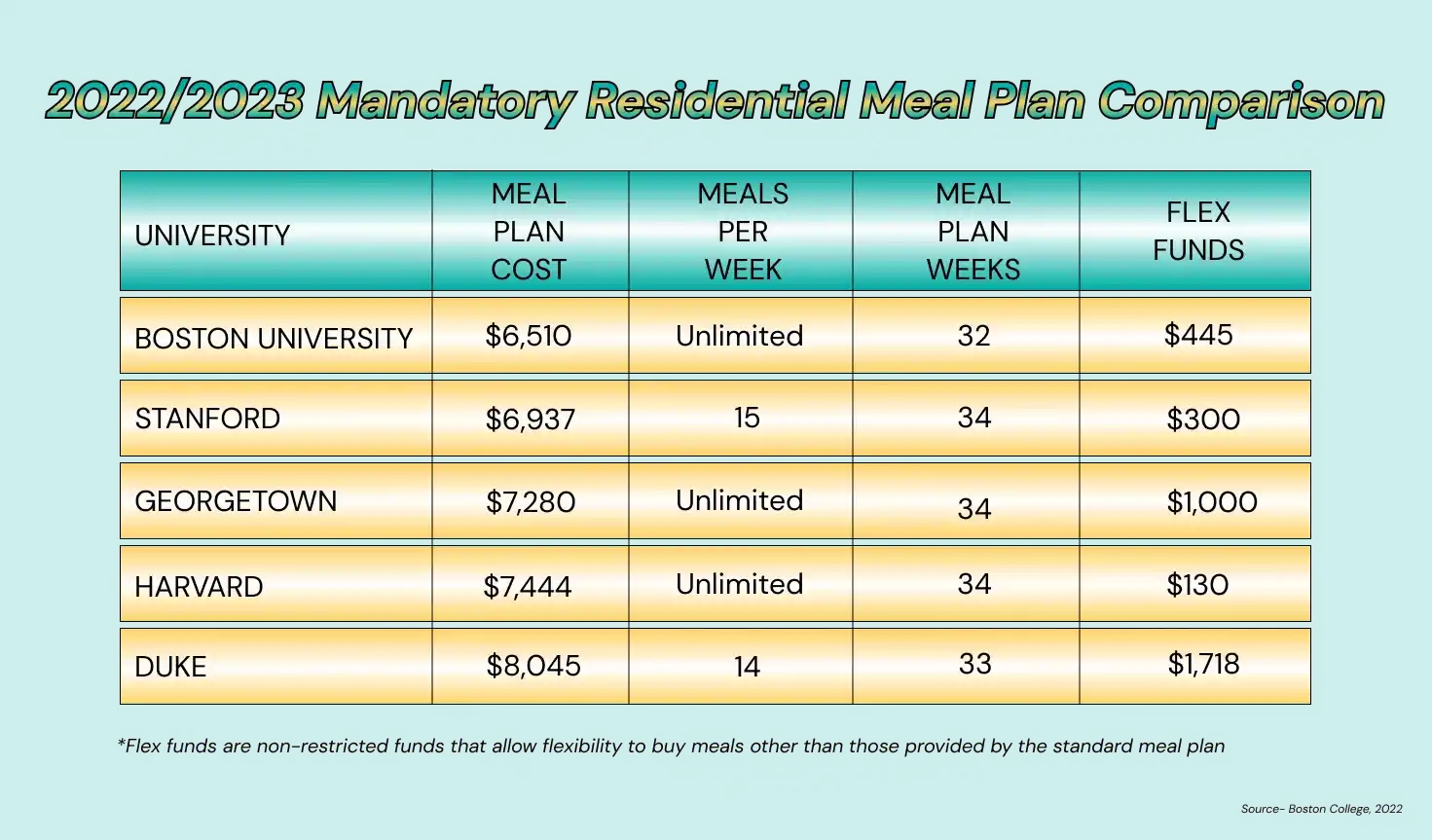If there is one thing everyone has in common on this planet, without exception, it is that we all need food. The harder a person works, either physically or mentally, the more food they need. Among all the people who need food, students are in the most disadvantaged situation: They study hard while often working physically, and yet they generally do not have much money to spend. Due to their young age and lack of experience, they also have little idea of how to spend the money they do have and of understanding rommate questions when they decide to share expenses on food. If you ask the average young learner, “How much do college students spend on food,” they are likely to have difficulty answering because they have no idea what these numbers actually are.
Today, we will try to figure out college student food expenses, whether this amount is the same for different learners, and how they can optimize their spending if are just getting ready for college or are aready in their first year.
Well, you know, college students often have to write essays on personal and social issues, such as financial struggles, and these topics are frequently discussed in class. For example, you may be assigned comparing dietary approaches based on your personal attitude to explore how different dietary choices impact both health and budget. In this article, we will not only discuss how much students spend on food but also offer you some valuable ideas that can inspire your future academic writing assignments related to nutrition.
Top 6 Factors Influencing Food Expenses in College for Students
To thoroughly investigate the question, “How much do college students spend on food,” let’s start with the basics — the factors influencing food costs in college. It’s no secret that all learners experience different life situations while studying at school, later choosing argumentative topics fast food for their papers. So, what influences how they spend money on food?
- Campus location. The college’s physical location greatly affects the cost of food among students. Those studying at urban campuses have a wider variety of dining options available to them but at higher prices. At the same time, those in rural areas have a more limited choice but lower food costs.
- Campus meal plans. These plans usually vary from college to college in terms of price and coverage. As a result, young people from different schools pay different prices for their meals on campus. At the University of Texas, meal plans for the 2021-2022 academic year began at $1,355 per semester. Meanwhile, Syracuse University in New York started from $4,135 per semester.
- Cooking areas. Access to kitchen facilities or appliances in dormitories directly affects the college student food expenses. If a person has no place to cook, they naturally eat out, and it costs them more than if they cooked their own meals.
- Eating habits and preferences. Another big factor in the “how much do students spend on food” issue is their specific eating habits, dietary preferences, and overall lifestyle. For instance, a vegan campus meal plan will cost a student $257. Some learners prefer eating fast food, while others choose healthier, home-cooked meals.
- Financial aid and budgeting. Financial means and budgeting are perhaps the most important factors influencing grocery spending among young people, as they directly affect how non‑tuition costs contribute to student debt. Those who have limited financial assistance or do not know how to plan their budgets wisely may have trouble spending on food.
- Social influence. Socializing with peers can’t help but affect food spending. Eating out budget with friends drains money, which may already be limited.
How much do college students spend on food per week? The average student spends about $102 per week on food without groceries.
How Much Do Students Spend On Food: Impact Of Dietary Requirements On Food Budget
As we’ve noted earlier, all students study in different circumstances while in college. We’re not talking about academic conditions right now but rather physical health. Even if, at first sight, a person seems quite healthy, this is not always the case. Conditions such as allergies, intolerances, diabetes, or gastrointestinal diseases directly affect what a young person eats and, thus, how much they spend on it. Special dietary needs often increase college student food expenses several times, which can be especially concerning for those wondering if a bachelor’s degree is worth it in the first place.
Balancing nutrition and budget in college for students with specific dietary needs
The following strategies can help young people eat well despite their particular dietary requirements:
- Create your own meal plan that meets your dietary needs and limits your college student food expenses. Choose simple recipes with accessible gluten-free, dairy-free, or low-sugar ingredients.
- Give preference to reasonably priced but nutritious foods that are right for you. Look for sales, discounts, and coupons for specialized allergy and intolerance products.
- Experiment with diverse and readily available ingredients such as beans, rice, lentils, and seasonal vegetables to create a variety of allergy-friendly meals that can reduce your grocery spending.
- Instead of expensive gluten-free baked goods, opt for natural, gluten-free products such as quinoa, corn tortillas, or oats, which are cheaper and more nutritious.
- Don’t neglect campus resources. Some colleges provide discounted or free specialty meals for students with dietary restrictions.

Balancing a budget as a college student is tough, especially when food costs start to add up. With limited funds and endless demands on time, many students struggle to find affordable and healthy options. Meal plans and off campus dining have their perks but cooking at home is the most budget friendly. But not everyone has the time or energy to meal plan or spend hours in the kitchen. And juggling assignments and exams can add to the stress so we need to find solutions for all aspects of student life.
When your plate is full—figuratively not literally—seeking help with other tasks like academic writing can free up time to focus on meal prep. Services like write my essay
can provide expert help so students can balance their food budget and live healthy without compromising their grades. By managing time and money wisely students can have a more balanced college life.
Comparing Meal Plans and Off-Campus Dining Costs
To give a more concrete answer to the question “How much do students spend on food,” let’s turn to the numbers, which, as they say, never lie.
How much do college students spend on food per month? Typically, learners who live off campus without a meal plan spend an average of $410 per month, which is about $102 per week for roughly 18 meals. These figures highlight the importance of factoring into the total cost of attendance—because food expenses, while non‑tuition, still significantly impact overall college costs. This amount, however, does not include grocery costs. In turn, students who have a meal plan pay an average of about $450 per month for it. However, this amount does not mean that the student does not additionally buy groceries outside the university. Thus, this amount is not fixed. Many young people prefer buying coffee, and their coffee expenses for a hot drink can reach a steep $4.
And, of course, the figure of $450 is an average, as the cost of meal plans differs from college to college. For example, at Florida Atlantic University, it costs $423, and at the University of Alaska Fairbanks, it costs as much as $619.
Managing food expenses is just one of the many financial headaches college students face. Balancing a tight budget with healthy eating requires thought and flexibility. For students with multiple responsibilities – from deadlines to part time jobs – finding time to cook or budget can be a nightmare. That’s where seeking help in other areas of life that are just as demanding, like academic writing, can make a big difference.
For example if you’re overwhelmed with coursework and dissertation requirements, consider getting help with dissertation. By outsourcing some of your academic workload to professionals, you can free up time to focus on personal growth – including learning to manage your food expenses. With the right balance you can navigate both your academic and financial responsibilities without compromising your well-being.
Average Monthly Food Costs for College Students: What Food Do Students Buy Most Often?
Very few young people can boast of a responsible attitude to their diet. There are two extremes in this regard: Either they eat very little in pursuit of artificial beauty standards, or they gorge themselves on fast food. In general, most people become responsible for their own diet, health, and money after graduating from college.
According to the students themselves, the most common meals they order are:
- Pizza
- Burgers
- Mac and cheese
- Chicken wings
- French fries
- Frozen yogurt
“Money isn’t a problem for me. I like to have lunch in Chinese restaurants. For me, it’s a little bit like being back home…”
Xiu Zhang, an international student in the USA
How much money do college students spend on food: Regional variations in food costs of students’ favorite meals
- The price for a large cheese pizza is $17.81 across the US. However, the regional cost differences for the tasty dish are pretty high. The most expensive pie is in Oregon, at $26.94, and the least expensive is in Oklahoma, at $12.70.
- Young people who like burgers are willing to pay $16 for them on average.
- Commonly available and one of the favorite dishes of college students, Mac and cheese costs between $3.00 and $6.50 in the United States.
- Fans of chicken wings pay an average of $3.90 per pound for them.
- French fries, a favorite side dish that is almost impossible to come by, cost $2.90 on average in the country.
- For a tasty and nutritious dessert — frozen yogurt — true lovers are willing to pay from $5 to $10 per person.
College students, how much do you spend on food? If you’re not one of those students who prefer fast food and want to manage your food expenses effectively and eat a balanced diet at a reasonable price, you can follow these three easy tips.
Top 3 easy-to-use strategies for managing food expenses:
- Limit your dining out. Think about cooking at home more often. Sometimes, going to a restaurant can be a nice change, but frequent eating out can cost you a pretty penny.
- Plan your meals for the week. How much do college students spend a week on food? More than $100! You can try to reduce this number. Make a 7-day meal plan based on budget recipes, draw up a list of necessary ingredients, and shop accordingly. This way, you will reduce the number of impulse purchases and food waste by several times.
- Make smart purchases. Choose generic brands, buy in bulk, and give preference to seasonal products for your grocery spending. Look for sales and discounts and use coupons whenever you can.

Recommended reads
College Student Food Expenses: FAQ
- How much does the average college student spend on food per month?
The average college student spends around $410 per month on food without groceries.
- What are the typical food expenses included in a college student’s budget?
Typical students who do not have severe health problems such as allergies, intolerances, or diabetes spend the lion’s share of their money on fast food.
- How do meal plans compare to off-campus dining in terms of cost?
Meal plans typically cost about $450 per month, while students living off campus without a meal plan spend an average of $410 per month on food without groceries.
*Disclaimer: All information is taken from open sources and may change over time. The site administration is not responsible for its reliability and relevance.






